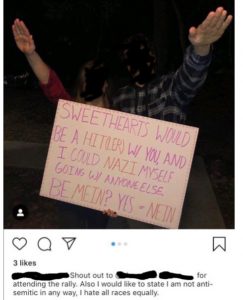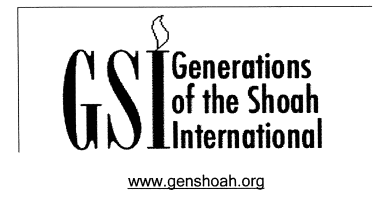 Last week, two students from Minnetonka High School in suburban Minneapolis posted a photo of themselves giving a Nazi hand salute accompanied by an antisemitic sign. This incident is just the latest of a number of similar instances, with photos surfacing from Indiana and Wisconsin showing students giving the Nazi salute. Understandably, each case has sparked calls for more and better Holocaust education in schools. This latest photo prompts the question: what do students in Minnesota’s public schools learn about the Holocaust?
Last week, two students from Minnetonka High School in suburban Minneapolis posted a photo of themselves giving a Nazi hand salute accompanied by an antisemitic sign. This incident is just the latest of a number of similar instances, with photos surfacing from Indiana and Wisconsin showing students giving the Nazi salute. Understandably, each case has sparked calls for more and better Holocaust education in schools. This latest photo prompts the question: what do students in Minnesota’s public schools learn about the Holocaust?
Gauging the state of Holocaust education in the United States is no easy task. The decentralized nature of American public schooling means that state departments of education, local districts, and individual classroom teachers decide what to teach and how it is taught. No comprehensive survey of the state of American Holocaust education exists, and such an assessment would be nearly impossible to conduct. The New York Times recently reported on an unsettling survey, which found that while the majority of Americans believe Holocaust education is important, many people, especially millennials, lack even a basic awareness of the history of the Holocaust. In 2013, Rhonda Fink-Whitman’s viral YouTube video showing American college student’s lack of knowledge of the Holocaust renewed a push for Holocaust education legislation in Pennsylvania and across the country. Indeed, Pennsylvania joined a growing list of states that have passed Holocaust education legislative mandates.


 Antisemitism from Muslims has become a serious issue in Western Europe, although not often acknowledged as such. Looking for insights into the views and rationales of young Muslims toward Jews, Günther Jikeli and his colleagues interviewed 117 ordinary Muslim men in London (chiefly of South Asian background), Paris (chiefly North African), and Berlin (chiefly Turkish).
Antisemitism from Muslims has become a serious issue in Western Europe, although not often acknowledged as such. Looking for insights into the views and rationales of young Muslims toward Jews, Günther Jikeli and his colleagues interviewed 117 ordinary Muslim men in London (chiefly of South Asian background), Paris (chiefly North African), and Berlin (chiefly Turkish). Dr. Günther Jikeli is a research fellow at the Moses Mendelssohn Center for European-Jewish Studies at Potsdam University. He is the co-director of the International Institute for Education and Research on Antisemitism (IIBSA). He earned his Ph.D.at the Center for Research on Antisemitism in Berlin and has served as an advisor to the Organization for Security and Co-operation in Europe on combating antisemitism. In 2013, he was awarded the Raoul Wallenberg Prize in Human Rights and Holocaust Studies by the International Raoul Wallenberg Foundation and Tel Aviv University.
Dr. Günther Jikeli is a research fellow at the Moses Mendelssohn Center for European-Jewish Studies at Potsdam University. He is the co-director of the International Institute for Education and Research on Antisemitism (IIBSA). He earned his Ph.D.at the Center for Research on Antisemitism in Berlin and has served as an advisor to the Organization for Security and Co-operation in Europe on combating antisemitism. In 2013, he was awarded the Raoul Wallenberg Prize in Human Rights and Holocaust Studies by the International Raoul Wallenberg Foundation and Tel Aviv University.  Dating back millennia, antisemitism has been called “the longest hatred.” Thought to be vanquished after the horrors of the Holocaust, in recent decades it has once again become a disturbing presence in many parts of the world. Resurgent Antisemitism presents original research that elucidates the social, intellectual, and ideological roots of the “new” antisemitism and the place it has come to occupy in the public sphere. By exploring the sources, goals, and consequences of today’s antisemitism and its relationship to the past, the book contributes to an understanding of this phenomenon that may help diminish its appeal and mitigate its more harmful effects.
Dating back millennia, antisemitism has been called “the longest hatred.” Thought to be vanquished after the horrors of the Holocaust, in recent decades it has once again become a disturbing presence in many parts of the world. Resurgent Antisemitism presents original research that elucidates the social, intellectual, and ideological roots of the “new” antisemitism and the place it has come to occupy in the public sphere. By exploring the sources, goals, and consequences of today’s antisemitism and its relationship to the past, the book contributes to an understanding of this phenomenon that may help diminish its appeal and mitigate its more harmful effects.